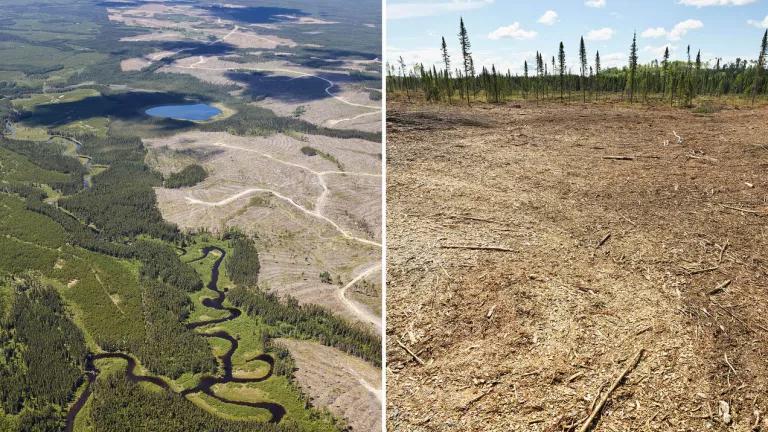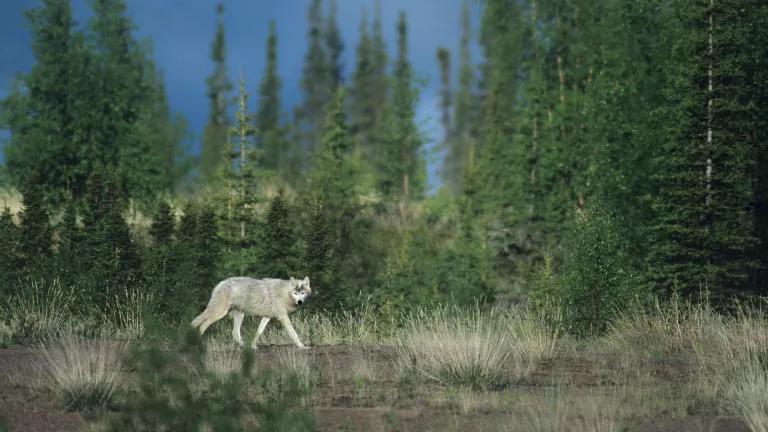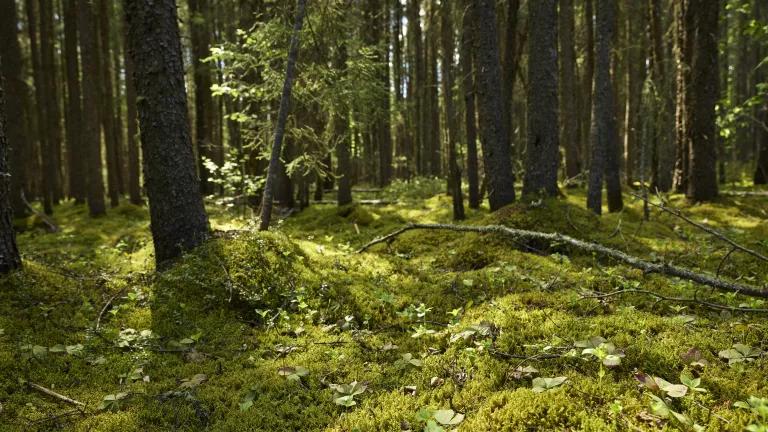Biden Administration Lays Out 30x30 Vision to Conserve Nature
The Conserving and Restoring America the Beautiful report opens the door to a new, more inclusive model for science-based, locally driven conservation of lands, inland waters, and ocean areas.
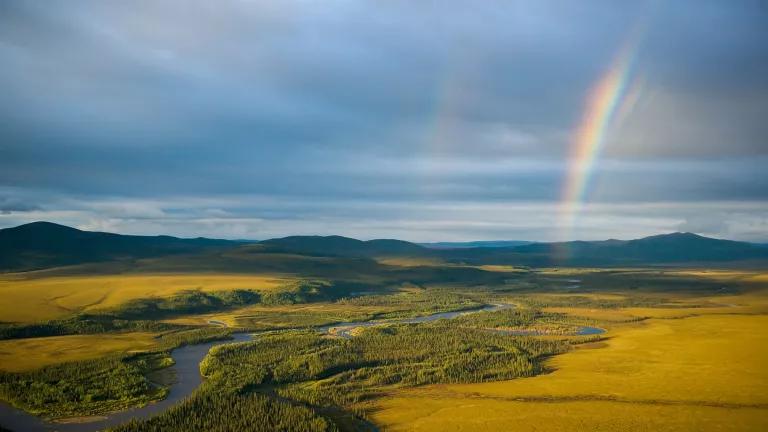
A rainbow arcs over the Selawik River in Alaska’s Selawik National Wildlife Refuge.
Steve Hillebrand/USFWS
The Conserving and Restoring America the Beautiful report opens the door to a new, more inclusive model for science-based, locally driven conservation of lands, inland waters, and ocean areas.
Soon after taking office, President Biden issued an executive order to tackle the climate crisis domestically and abroad. In it, he established a national goal to conserve at least 30 percent of U.S. lands and freshwater and 30 percent of U.S. ocean areas by 2030, in an initiative commonly referred to as 30x30. This initiative seeks to reverse the negative impacts of biodiversity decline and climate change by protecting more natural areas, and to increase access to nature for communities that lack it. Upon his announcement, President Biden directed his administration to create a report that outlines how 30x30 will support the efforts of people across the country to achieve the nation’s habitat conservation goals.
Recent nationwide polling shows Americans strongly back the protection of the nation’s natural heritage; four out of five U.S. voters favor a plan to protect at least 30 percent of America’s land, ocean areas, and inland waters by the year 2030 because they understand it will be good for their well-being and the environment. Conservation and environmental groups have also shown their support, as more than 300 groups from across the nation signed a letter in early April.
The Biden administration recognizes the widespread support for 30x30 and the new report proposes an America the Beautiful Campaign—a “ten-year, locally led campaign to conserve and restore the lands and waters upon which we all depend, and that bind us together as Americans.” It moves the administration’s 30x30 goal forward by proposing:
- Eight principles to guide the effort:
- Pursue a Collaborative and Inclusive Approach to Conservation
- Conserve America’s Lands and Waters for the Benefit of All People
- Support Locally Led and Locally Designed Conservation Efforts
- Honor Tribal Sovereignty and Support the Priorities of Tribal Nations
- Pursue Conservation and Restoration Approaches that Create Jobs and Support Healthy Communities
- Honor Private Property Rights and Support the Voluntary Stewardship Efforts of Private Landowners and Fishers
- Use Science as a Guide
- Build on Existing Tools and Strategies with an Emphasis on Flexibility and Adaptive Approaches
- The building of an “American Conservation and Stewardship Atlas:” an accessible and evolving mapping or other database tool that provides a baseline of information on lands and waters that have already been conserved or restored—and against which we can measure the progress of conservation, stewardship, and restoration efforts across the United States
- The publication of an annual public “America the Beautiful” report, updating the progress being made to support conservation and restoration efforts across the country, as well as the condition of fish and wildlife habitats and populations
- Recommendations for early focus:
- Create more parks and safe outdoor opportunities in nature-deprived communities
- Support Tribally led conservation and restoration priorities
- Expand collaborative conservation of fish and wildlife habitats and corridors
- Increase access for outdoor recreation
- Incentivize and reward the voluntary conservation efforts of fishers, ranchers, farmers, and forest owners
- Create jobs by investing in restoration and resilience
Critically, the report highlights the need to bring together diverse voices—including voices that have too often been excluded from the decision-making processes around conservation. The 30x30 initiative opens the door to a new, more inclusive model of conservation that is science-based, locally driven, and engages all stakeholders, from tribal and Indigenous communities to farmers, ranchers, and outdoors enthusiasts.
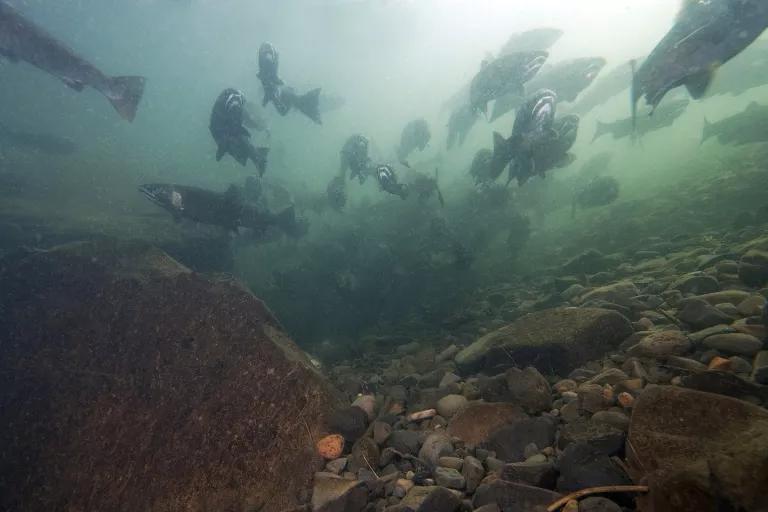
Coho salmon swimming in Eagle Creek, Oregon, a tributary of the Columbia River
Rick Swart/Oregon Department of Fish & Wildlife (ODFW)
There is no one-size-fits-all solution for conserving our lands, and the ways we can achieve the 30x30 vision are as varied as the landscapes we are trying to protect. The America the Beautiful Campaign could provide an opportunity for communities to tell their stories about the special places they want to protect—the places we depend upon for clean air, clean water, food security, and abundant native wildlife. In short, the natural life support systems on which we all depend, now and in the future.
Government at all levels has a critical role to play in providing the tools and funds to ensure that more Americans can participate in land conservation efforts in their own communities. We can start with the low-hanging fruit of existing public lands, waters, and ocean areas, and assessing what role they could play in 30x30. How do they contribute to our biodiversity and climate goals? Do they need restoration? Do they require additional layers of protection to secure natural ecosystems for future generations? And we can examine how to equitably provide funding and programs for private landowners who want to conserve their land with enduring measures as part of the 30x30 vision. We also need to ensure that existing legal protections for these resources are adequately enforced.
To maximize the biodiversity and climate mitigation benefits of 30x30, we need to look beyond just our public lands and forge a new relationship with nature across the board, one that works in harmony with nature rather than battling it. For example, several migrating bird species may depend on a nesting area in a large intact forest, and they also may need healthy and safe wetlands on their migration route. Protecting and revitalizing these landscapes aren’t just good for birds—healthy forests and wetlands sequester carbon from the atmosphere, replenish and clean our water supplies, and provide access to nature for nearby residents. Healthy riparian forests provide corridors for wildlife to travel safely between disjointed habitats and, along with wetlands, also absorb harmful floodwaters, reduce threats to downstream residents, and act as natural filters to reduce water contamination. All of these considerations need to take place in the context of the climate crisis, with an eye toward how we can best support natural systems to maximize carbon sequestration and build resilience.
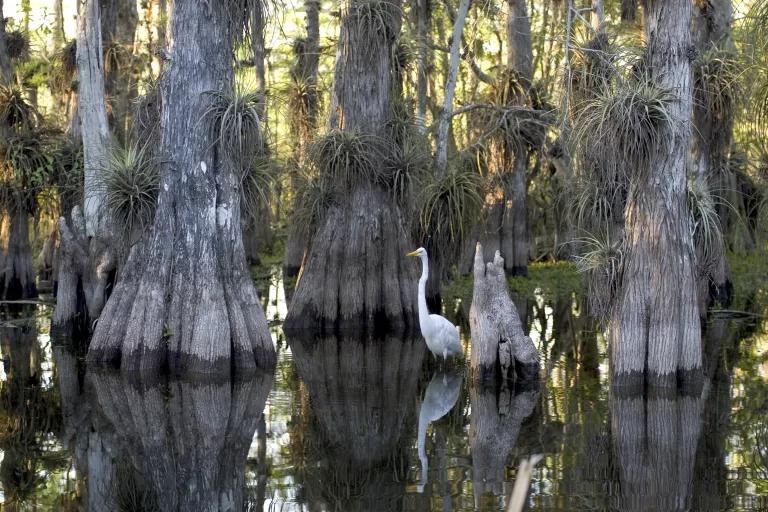
A great egret wades among the trees in Florida’s Everglades National Park
R. Cammauf/NPS
So, as the Conserving and Restoring America the Beautiful report makes clear, now is the time for ideas. Let’s put everything on the table. Let’s engage in a national conversation on how to best invest in rural communities and working landscapes, empower place-based collaborative conservation, maintain and strengthen legal safeguards, and create economic drivers for the voluntary conservation efforts of private landowners, water users, and working waterfronts. And as we consider new ideas, let’s also think about our successes: 30x30 and other conservation campaigns are an opportunity for us to embrace new strategies to ensure our existing parks and preserves can support biodiversity and help species survive the increasing stresses of climate change. If something works, let’s consider replicating it, such as creating new parks where needed, but also learning from past mistakes, especially when it comes to collaboration with tribal and Indigenous communities.
The Biden administration’s commitment to 30x30 is exciting, not just because the government is finally moving forward with a necessary agenda to secure healthy ecosystems and what they supply for future generations, but also because it taps into people’s desires to solve our big problems together. As the report makes clear, 30x30 is an avenue for that collaboration.


